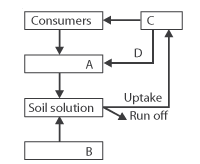Which one of the following is a characteristic feature of cropland ecosystem?
(1) Least genetic diversity
(2) The absence of weeds
(3) Ecological succession
(4) The absence of soil organisms
Which of the following would appear as the pioneer organisms on bare rocks?
(1) Liverworts
(2) Mosses
(3) Green algae
(4) Lichens
The term ecosystem was coined by
(1) AG Tansley
(2) E Haeckel
(3) E Warming
(4) EP Odum
In which of the following both pairs have the correct combination?
| 1. | Gaseous nutrient cycle Sedimentary nutrient cycle |
Carbon and nitrogen Sulphur and phosphorus |
| 2. | Gaseous nutrient cycle Sedimentary nutrient cycle |
Carbon and sulphur Nitrogen and phosphorus |
| 3. | Gaseous nutrient cycle Sedimentary nutrient cycle |
Nitrogen and sulphur Carbon and phosphorus |
| 4. | Gaseous nutrient cycle Sedimentary nutrient cycle |
Sulphur and phosphorus Carbon and nitrogen |
Vertical distribution of different species occupying different levels in a biotic community is
known as
1. divergence
2. stratification
3. zonation
4. pyramid
Secondary succession takes place on/in
(1) bara rock
(2) degraded forest
(3) newly created pond
(4) newly cooled lava
The mass of living material at a tropic level at a particular time is called
1. Gross primary productivity
2. Standing state
3. Net primary productivity
4. standing crop
Match the following and select the correct option.
Column I Column II
A. Earthworm 1. Pioneer species
B. Succession 2. Detritivore
C. Ecosystem service 3. Natality
D. Population growth 4. Pollination
A B C D
(1) 1 2 3 4
(2) 4 1 3 2
(3) 3 2 4 1
(4) 2 1 4 3
Given below is a simplified model of phosphorus cycling in a terrestrial ecosystem with
four blanks (A-D). Identify the blanks.

| A | B | C | D | |
| 1. | Rock minerals | Detritus | Litterfall | Producers |
| 2. | Litterfall | Producer | Rock minerals | Detritus |
| 3. | Detritus | Rock minerals | Producer | Litterfall |
| 4. | Producer | Litterfall | Rock minerals | Detritus |
Secondary productivity is rate of formation of new organic matter by
1. producer
2. parasite
3. consumer
4. decomposer






